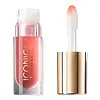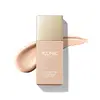What's inside
What's inside
 Key Ingredients
Key Ingredients

 Benefits
Benefits

 Concerns
Concerns

 Ingredients Side-by-side
Ingredients Side-by-side

C21-28 Alkane
EmollientDiisostearyl Malate
EmollientHydrogenated Styrene/Isoprene Copolymer
Helianthus Annuus Seed Oil
EmollientEthylhexyl Palmitate
EmollientAroma
Pentaerythrityl Tetra-Di-T-Butyl Hydroxyhydrocinnamate
AntioxidantLauric Acid
CleansingPentylene Glycol
Skin ConditioningCI 19140
Cosmetic ColorantLauryl Alcohol Diphosphonic Acid
Emulsion StabilisingTrihydroxystearin
Skin ConditioningDiethylhexyl Syringylidenemalonate
Skin ProtectingLecithin
EmollientCI 15850
Cosmetic ColorantAlkanna Tinctoria Root Extract
Skin ConditioningTocopherol
AntioxidantCaprylic/Capric Triglyceride
MaskingCI 77491
Cosmetic ColorantCI 77492
Cosmetic ColorantSodium Hyaluronate
HumectantAscorbyl Palmitate
AntioxidantSolanum Lycopersicum Fruit Extract
AntioxidantCitric Acid
BufferingGlucomannan
Skin ConditioningC21-28 Alkane, Diisostearyl Malate, Hydrogenated Styrene/Isoprene Copolymer, Helianthus Annuus Seed Oil, Ethylhexyl Palmitate, Aroma, Pentaerythrityl Tetra-Di-T-Butyl Hydroxyhydrocinnamate, Lauric Acid, Pentylene Glycol, CI 19140, Lauryl Alcohol Diphosphonic Acid, Trihydroxystearin, Diethylhexyl Syringylidenemalonate, Lecithin, CI 15850, Alkanna Tinctoria Root Extract, Tocopherol, Caprylic/Capric Triglyceride, CI 77491, CI 77492, Sodium Hyaluronate, Ascorbyl Palmitate, Solanum Lycopersicum Fruit Extract, Citric Acid, Glucomannan
Water
Skin ConditioningDimethicone
EmollientTalc
AbrasiveDicaprylyl Carbonate
EmollientIsostearyl Neopentanoate
EmollientGlycerin
HumectantDimethicone/Vinyl Dimethicone Crosspolymer
Skin ConditioningPEG-10 Dimethicone
Skin ConditioningTrimethylsiloxysilicate
EmollientIsododecane
EmollientBis-PEG/PPG-14/14 Dimethicone
EmollientPhenoxyethanol
PreservativeSodium Chloride
MaskingMagnesium Sulfate
Hydrogen Dimethicone
Sodium Dehydroacetate
PreservativeDisteardimonium Hectorite
StabilisingSilica
AbrasivePrunus Persica Flower Extract
MoisturisingBenzoic Acid
MaskingAluminum Hydroxide
EmollientC24-28 Alkyl Methicone
EmollientCollagen Amino Acids
MoisturisingMaltodextrin
AbsorbentDehydroacetic Acid
PreservativePisum Sativum Extract
Skin ConditioningPropylene Carbonate
SolventLeuconostoc/Radish Root Ferment Filtrate
AntimicrobialSodium Citrate
BufferingEthylhexylglycerin
Skin ConditioningLaureth-4
EmulsifyingCamellia Sinensis Leaf Extract
AntimicrobialSodium Benzoate
MaskingTocopherol
AntioxidantCitric Acid
BufferingCI 77891
Cosmetic ColorantCI 77492
Cosmetic ColorantCI 77491
Cosmetic ColorantCI 77499
Cosmetic ColorantWater, Dimethicone, Talc, Dicaprylyl Carbonate, Isostearyl Neopentanoate, Glycerin, Dimethicone/Vinyl Dimethicone Crosspolymer, PEG-10 Dimethicone, Trimethylsiloxysilicate, Isododecane, Bis-PEG/PPG-14/14 Dimethicone, Phenoxyethanol, Sodium Chloride, Magnesium Sulfate, Hydrogen Dimethicone, Sodium Dehydroacetate, Disteardimonium Hectorite, Silica, Prunus Persica Flower Extract, Benzoic Acid, Aluminum Hydroxide, C24-28 Alkyl Methicone, Collagen Amino Acids, Maltodextrin, Dehydroacetic Acid, Pisum Sativum Extract, Propylene Carbonate, Leuconostoc/Radish Root Ferment Filtrate, Sodium Citrate, Ethylhexylglycerin, Laureth-4, Camellia Sinensis Leaf Extract, Sodium Benzoate, Tocopherol, Citric Acid, CI 77891, CI 77492, CI 77491, CI 77499
Ingredients Explained
These ingredients are found in both products.
Ingredients higher up in an ingredient list are typically present in a larger amount.
Ci 77491 is also hydrated iron III oxide. It's sole purpose is to give a red/pink hue to products.
Iron III oxides are classified as inorganic chemicals for coloring.
Synthetically created Ci 77491 is considered safer than those naturally found. This is because the synthetically created version may contain less impurities. Iron oxides are generally non-toxic and non-allergenic.
Learn more about CI 77491Ci 77492 is also hydrated iron III oxide. It's sole purpose is to give a yellow hue to products.
Iron III oxides are classified as inorganic chemicals for coloring.
Synthetically created Ci 77492 is considered safer than those naturally found. This is because the synthetically created version may contain less impurities. Iron oxides are generally non-toxic and non-allergenic.
Learn more about CI 77492Citric Acid is an alpha hydroxy acid (AHA) naturally found in citrus fruits like oranges, lemons, and limes.
Like other AHAs, citric acid can exfoliate skin by breaking down the bonds that hold dead skin cells together. This helps reveal smoother and brighter skin underneath.
However, this exfoliating effect only happens at high concentrations (20%) which can be hard to find in cosmetic products.
Due to this, citric acid is usually included in small amounts as a pH adjuster. This helps keep products slightly more acidic and compatible with skin's natural pH.
In skincare formulas, citric acid can:
While it can provide some skin benefits, research shows lactic acid and glycolic acid are generally more effective and less irritating exfoliants.
Most citric acid used in skincare today is made by fermenting sugars (usually from molasses). This synthetic version is identical to the natural citrus form but easier to stabilize and use in formulations.
Read more about some other popular AHA's here:
Learn more about Citric AcidTocopherol (also known as Vitamin E) is a common antioxidant used to help protect the skin from free-radicals and strengthen the skin barrier. It's also fat soluble - this means our skin is great at absorbing it.
Vitamin E also helps keep your natural skin lipids healthy. Your lipid skin barrier naturally consists of lipids, ceramides, and fatty acids. Vitamin E offers extra protection for your skin’s lipid barrier, keeping your skin healthy and nourished.
Another benefit is a bit of UV protection. Vitamin E helps reduce the damage caused by UVB rays. (It should not replace your sunscreen). Combining it with Vitamin C can decrease sunburned cells and hyperpigmentation after UV exposure.
You might have noticed Vitamin E + C often paired together. This is because it is great at stabilizing Vitamin C. Using the two together helps increase the effectiveness of both ingredients.
There are often claims that Vitamin E can reduce/prevent scarring, but these claims haven't been confirmed by scientific research.
Learn more about Tocopherol